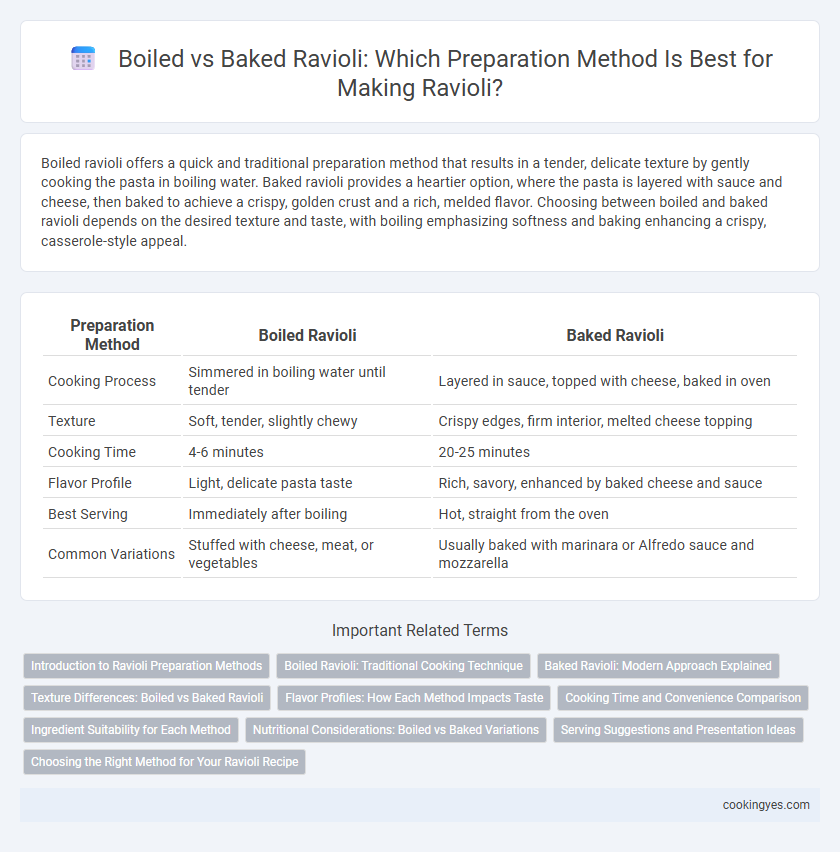Boiled ravioli offers a quick and traditional preparation method that results in a tender, delicate texture by gently cooking the pasta in boiling water. Baked ravioli provides a heartier option, where the pasta is layered with sauce and cheese, then baked to achieve a crispy, golden crust and a rich, melded flavor. Choosing between boiled and baked ravioli depends on the desired texture and taste, with boiling emphasizing softness and baking enhancing a crispy, casserole-style appeal.
Table of Comparison
| Preparation Method | Boiled Ravioli | Baked Ravioli |
|---|---|---|
| Cooking Process | Simmered in boiling water until tender | Layered in sauce, topped with cheese, baked in oven |
| Texture | Soft, tender, slightly chewy | Crispy edges, firm interior, melted cheese topping |
| Cooking Time | 4-6 minutes | 20-25 minutes |
| Flavor Profile | Light, delicate pasta taste | Rich, savory, enhanced by baked cheese and sauce |
| Best Serving | Immediately after boiling | Hot, straight from the oven |
| Common Variations | Stuffed with cheese, meat, or vegetables | Usually baked with marinara or Alfredo sauce and mozzarella |
Introduction to Ravioli Preparation Methods
Boiled ravioli involves cooking the pasta pockets in rapidly boiling water, ensuring a tender texture and evenly heated filling, preferred for its simplicity and quick preparation. Baked ravioli is typically breaded and layered with sauce and cheese before baking, resulting in a crispy exterior and rich, melded flavors that enhance the overall dish. Both methods highlight different textures and taste profiles, catering to diverse culinary preferences and meal presentations.
Boiled Ravioli: Traditional Cooking Technique
Boiled ravioli is the traditional cooking method that involves submerging pasta pockets filled with cheese, meat, or vegetables into rapidly boiling water until they float to the surface, indicating doneness. This technique preserves the delicate texture of fresh pasta while ensuring the filling is thoroughly heated. Boiling allows for a tender, moist ravioli with a soft exterior, offering a classic Italian culinary experience unmatched by baking.
Baked Ravioli: Modern Approach Explained
Baked ravioli offers a modern approach by combining crispy textures with gooey cheese, elevating traditional flavors through oven roasting. This method enhances the pasta's exterior while maintaining a tender interior, making it a popular alternative to the classic boiled ravioli technique. Baked ravioli is often layered with marinara sauce and mozzarella, creating a rich, hearty dish that requires less hands-on preparation time.
Texture Differences: Boiled vs Baked Ravioli
Boiled ravioli features a tender, smooth texture with a delicate bite due to being cooked in water, maintaining the pasta's moisture. Baked ravioli develops a crispy, golden exterior while retaining a soft, cheesy inside, offering a contrast of crunchy and creamy textures. Choosing boiling preserves a classic, supple mouthfeel, whereas baking introduces a robust, layered texture experience.
Flavor Profiles: How Each Method Impacts Taste
Boiled ravioli retains a delicate, tender texture that highlights the freshness of the pasta and filling, resulting in a subtle, mildly savory flavor. Baked ravioli develops a crispy, golden exterior that adds a rich, toasted depth, enhancing the overall taste with caramelized notes and a heartier mouthfeel. Each preparation method significantly influences the flavor profile, with boiling emphasizing softness and filling purity, while baking introduces a robust, crunchy contrast.
Cooking Time and Convenience Comparison
Boiled ravioli typically cooks in 4 to 6 minutes, offering a quick preparation method ideal for busy meals. Baked ravioli requires about 20 to 30 minutes, including baking with sauce and cheese, making it more time-consuming but adds a crispy, golden texture. Boiling is more convenient for fast cooking, while baking provides enhanced flavor and texture for a hands-off meal.
Ingredient Suitability for Each Method
Boiled ravioli works best with fresh, thin pasta dough that cooks quickly and remains tender, making delicate fillings like ricotta or spinach ideal. Baked ravioli suits heartier ingredients such as meats and robust cheeses, as the baking process melds flavors and crisps the pasta edges. Selecting the preparation method depends on the filling's texture and moisture, with boiled ravioli offering a soft bite and baked ravioli creating a rich, caramelized finish.
Nutritional Considerations: Boiled vs Baked Variations
Boiled ravioli retains more moisture and typically contains fewer calories and less fat compared to baked ravioli, which absorbs additional oils and cheeses during baking. Baked ravioli tends to have higher protein due to cheese toppings but also increases sodium and saturated fat content. Choosing boiled ravioli suits lower-calorie and lower-fat diets, while baked variations offer richer flavors with elevated nutrient density and calories.
Serving Suggestions and Presentation Ideas
Boiled ravioli offers a classic, smooth texture that pairs well with delicate sauces like marinara or Alfredo, making it ideal for simple plating with fresh herbs and grated Parmesan. Baked ravioli provides a crispy, golden crust perfect for layering in casseroles or serving with a rich tomato sauce topped with melted mozzarella for a hearty presentation. Both methods can be enhanced by garnishing with basil leaves or a sprinkle of red pepper flakes to elevate visual appeal and flavor.
Choosing the Right Method for Your Ravioli Recipe
Boiled ravioli delivers a tender, supple texture ideal for traditional fillings like cheese or spinach, while baked ravioli creates a crispy, golden crust that enhances heartier, meat-filled varieties. Selecting the right method depends on the desired texture and flavor profile; boiled methods preserve moisture, whereas baking adds a savory, toasted element. Consider ingredient composition and dish presentation to optimize cooking techniques for the perfect ravioli experience.
Boiled Ravioli vs Baked Ravioli for preparation method Infographic

 cookingyes.com
cookingyes.com